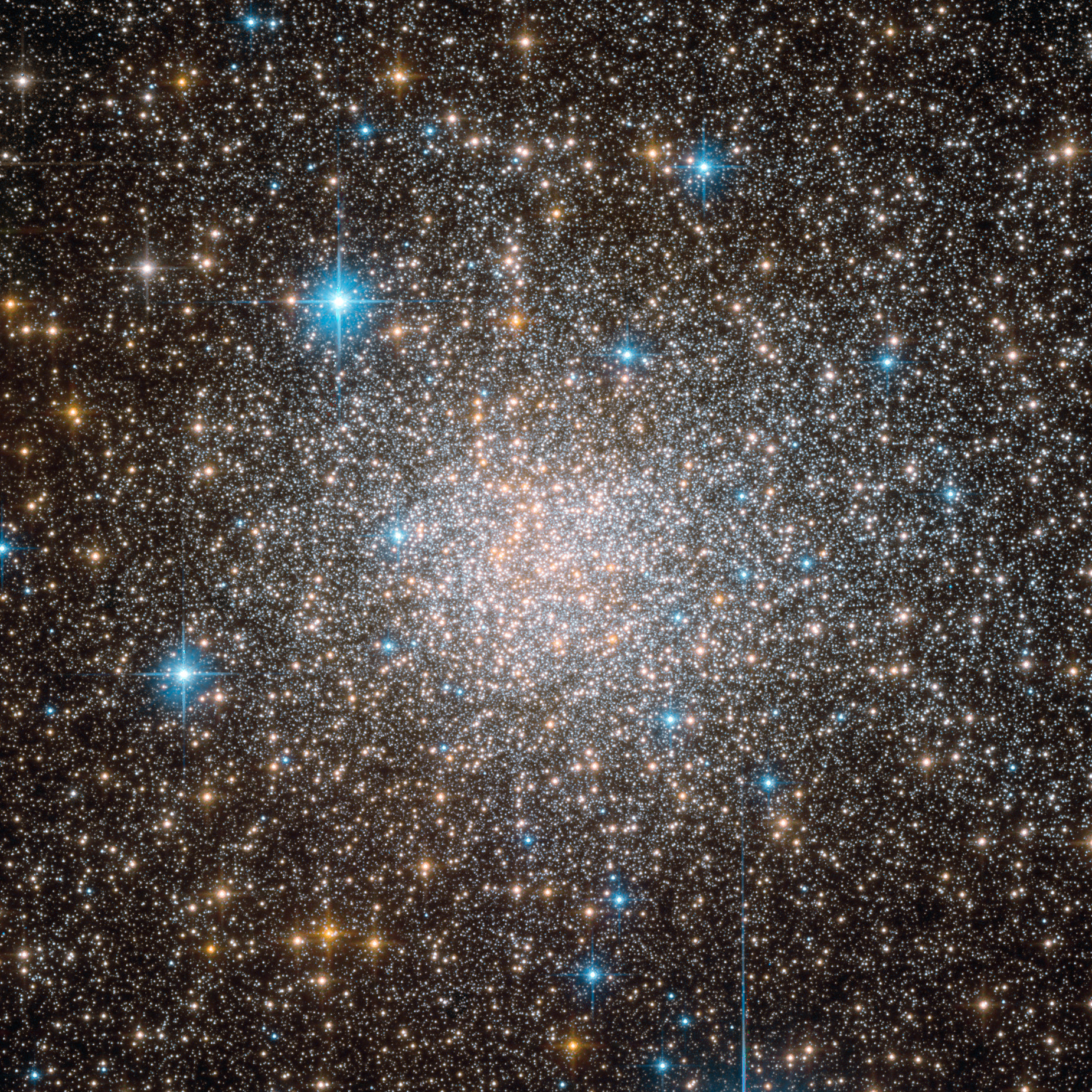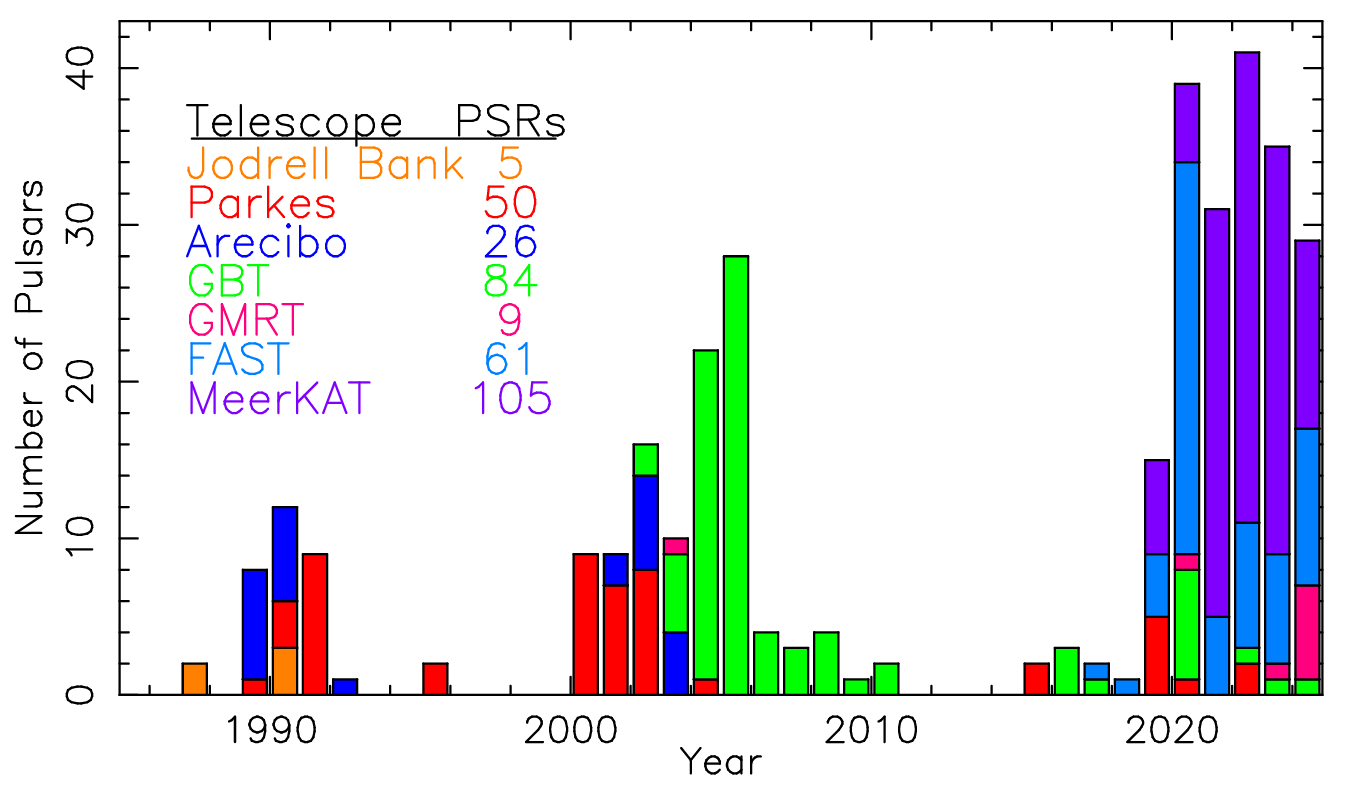 The globular cluster Terzan5 as seen by HST (NASA).
The globular cluster Terzan5 as seen by HST (NASA).We have been using one of the world’s largest radio telescopes, the NSF-funded Green Bank Telescope (or GBT), for the past 20 years to uncover and monitor ∼80 new globular cluster pulsars, many of them with unique properties that enable unexpected scientific measurements. We have accumulated roughly 1,500 hours of GBT data for these studies over this time, the vast majority of which is not archived or available to the public. In addition, we have recently been awarded a large GBT observing program (GBT24B-410 for 210 hours) for the next three years to continue this work.
The Team
- Scott Ransom (PI; NRAO)
- Paulo Freire (MPIfR)
- Ingrid Stairs (UBC)
- Jason Hessels (U. Amsterdam / McGill U.)
- Ryan Lynch (NRAO)
- Megan DeCesar (George Mason U.)
Background
Radio pulsars are spinning neutron stars which act as cosmic clocks, allowing us to make precision measurements of a wide variety of astrophysical processes. Some of the most interesting radio pulsars are those which spin hundreds of times per second, the so-called millisecond pulsars (MSPs). Most MSPs happen to be in binary systems with another star, and the clock-like pulsations let us measure those orbits extremely precisely. The amount of science that pulsars produce tends to increase with the overall time span that we monitor the pulsars, with decades-long observing campaigns being extremely rare and valuable.
Globular clusters, ancient groupings of hundreds of thousands of stars which orbit our Milky Way galaxy, are factories for these millisecond and binary pulsars. The stars are so close together that they interact with each other over cosmic times, producing exotic pulsar binaries that we can measure today. Unfortunately these clusters are distant, and pulsars are very faint, so we need the largest radio telescopes on Earth to measure them.
 Globular cluster pulsars as a function of time and telescope.
Globular cluster pulsars as a function of time and telescope.Previous project codes
GBT04A-029, GBT05A-011, GBT05C-042, GBT06A-053, GBT06B-032, GBT06C-052, GBT07A-094, GBT07B-025, GBT07C-062, GBT08C-076, GBT09C-058, GBT10C-049, GBT12A-391, GBT13A-438, GBT14A-443, GBT14B-218, GBT15B-238, GBT16B-301, GBT17A-305, GBT17B-256, GBT18B-072, GBT19B-264, GBT20B-333, GBT21A-344, GBT21B-277, GBT22B-256, GBT23B-225, GBT24A-375
The Clusters
We observe the pusars in the following globular clusters:
- Terzan 5 (49 pulsars)
- M28 (NGC 6626) (14 pulsars)
- NGC 6440 (8 pulsars)
- NGC 6652 (2 pulsars)
- NGC 6544 (3 pulsars)
Our Published Results
We have published lots of papers on this and closely related work over the last 20+ years, many of which have been lead by students:
Rosenthal, Alexandra C., Ransom, Scott M., et al. 2025, ApJ A 34 yr Timing Solution of the Redback Millisecond Pulsar Terzan 5A
Corcoran, Kyle A., Ransom, Scott M., et al. 2024, arXiv, A Novel Technique for Long-term Timing of Redback Millisecond Pulsars
McCarver, Amaris V., Maccarone, Thomas J., et al. 2024, ApJ, A VLITE Search for Millisecond Pulsars in Globular Clusters: Discovery of a Pulsar in GLIMPSE-C01
Padmanabh, P. V., Ransom, S. M., et al. 2024, A&A, Discovery and timing of ten new millisecond pulsars in the globular cluster Terzan 5
Taylor, Jackson, Ransom, Scott, & Padmanabh, Prajwal V. 2024, ApJ, Algorithmic Pulsar Timer for Binaries
Barr, Ewan D., Dutta, Arunima, et al. 2024, Science, A pulsar in a binary with a compact object in the mass gap between neutron stars and black holes
Li, Dongzi, Bilous, Anna, et al. 2023, Nature, A highly magnetized environment in a pulsar binary system
Balakrishnan, Vishnu, Freire, Paulo C. C., et al. 2023, ApJ, Missing for 20 yr: MeerKAT Redetects the Elusive Binary Pulsar M30B
Vurgun, Eda, Linares, Manuel, et al. 2022, ApJ, The Neutron Star Population in M28: A Joint Chandra/GBT Look at Pulsar Paradise
Martsen, Ashley R., Ransom, Scott M., et al. 2022, ApJ, Radio Pulse Profiles and Polarization of the Terzan 5 Pulsars
Gautam, T., Ridolfi, A., et al. 2022, A&A, Upgraded GMRT survey for pulsars in globular clusters. I. Discovery of a millisecond binary pulsar in NGC 6652
Ridolfi, A., Freire, P. C. C., et al. 2022, A&A, TRAPUM discovery of 13 new pulsars in NGC 1851 using MeerKAT
Abbate, F., Ridolfi, A., et al. 2022, MNRAS, Four pulsar discoveries in NGC 6624 by TRAPUM using MeerKAT
Vleeschower, L., Stappers, B. W., et al. 2022, MNRAS, Discoveries and timing of pulsars in NGC 6440
Douglas, Andrew, Padmanabh, Prajwal V., et al. 2022, ApJ, Two New Black Widow Millisecond Pulsars in M28
Pan, Zhichen, Qian, Lei, et al. 2021, ApJ, FAST Globular Cluster Pulsar Survey: Twenty-four Pulsars Discovered in 15 Globular Clusters
Ridolfi, A., Gautam, T., et al. 2021, MNRAS, Eight new millisecond pulsars from the first MeerKAT globular cluster census
Bogdanov, Slavko, Bahramian, Arash, et al. 2021, ApJ, A Deep Chandra X-Ray Observatory Study of the Millisecond Pulsar Population in the Globular Cluster Terzan 5
Urquhart, Ryan, Bahramian, Arash, et al. 2020, ApJ, The MAVERIC Survey: New Compact Binaries Revealed by Deep Radio Continuum Observations of the Galactic Globular Cluster Terzan 5
Ridolfi, A., Freire, P. C. C., et al. 2019, MNRAS, Upgraded Giant Metrewave Radio Telescope timing of NGC 1851A: a possible millisecond pulsar - neutron star system
Bilous, A. V., Ransom, S. M., & Demorest, P. 2019, ApJ, Unusually Bright Single Pulses from the Binary Pulsar B1744-24A: A Case of Strong Lensing?
Bahramian, Arash, Strader, Jay, et al. 2018, ApJ, The MAVERIC Survey: A Transitional Millisecond Pulsar Candidate in Terzan 5
Andersen, Bridget C. & Ransom, Scott M. 2018, ApJ, A Fourier Domain “Jerk” Search for Binary Pulsars
Cadelano, M., Ransom, S. M., et al. 2018, ApJ, Discovery of Three New Millisecond Pulsars in Terzan 5
Prager, Brian J., Ransom, Scott M., et al. 2017, ApJ, Using Long-term Millisecond Pulsar Timing to Obtain Physical Characteristics of the Bulge Globular Cluster Terzan 5
DeCesar, Megan E., Ransom, Scott M., et al. 2015, ApJ, A Highly Eccentric 3.9 Millisecond Binary Pulsar in the Globular Cluster NGC 6652
Bilous, A. V., Pennucci, T. T., et al. 2015, ApJ, A Broadband Radio Study of the Average Profile and Giant Pulses from PSR B1821-24A
Johnson, T. J., Guillemot, L., et al. 2013, ApJ, Broadband Pulsations from PSR B1821-24: Implications for Emission Models and the Pulsar Population of M28
Lynch, Ryan S., Lorimer, Duncan R., et al. 2012, ApJ, A Population of Non-recycled Pulsars Originating in Globular Clusters
Lynch, Ryan S., Freire, Paulo C. C., et al. 2012, ApJ, The Timing of Nine Globular Cluster Pulsars
Boyles, J., Lorimer, D. R., et al. 2011, ApJ, Young Radio Pulsars in Galactic Globular Clusters
Lynch, Ryan S., Ransom, Scott M., et al. 2011, ApJ, Six New Recycled Globular Cluster Pulsars Discovered with the Green Bank Telescope
Bogdanov, Slavko, van den Berg, Maureen, et al. 2011, ApJ, Chandra X-ray Observations of 12 Millisecond Pulsars in the Globular Cluster M28
Lynch, Ryan S. & Ransom, Scott M. 2011, ApJ, A New Pulsar in Green Bank Telescope Searches of 10 Globular Clusters
Pallanca, C., Dalessandro, E., et al. 2010, ApJ, The Optical Companion to the Binary Millisecond Pulsar J1824-2452H in the Globular Cluster M28
Freire, Paulo C. C., Ransom, Scott M., et al. 2008, ApJ, Eight New Millisecond Pulsars in NGC 6440 and NGC 6441
Freire, Paulo C. C., Ransom, Scott M., & Gupta, Yashwant 2007, ApJ, Timing the Eccentric Binary Millisecond Pulsar in NGC 1851
Hessels, Jason W. T., Ransom, Scott M., et al. 2006, Science A Radio Pulsar Spinning at 716 Hz
Ransom, Scott M., Hessels, Jason W. T., et al. 2005, Science Twenty-One Millisecond Pulsars in Terzan 5 Using the Green Bank Telescope
Ransom, Scott M., Stairs, Ingrid H., et al. 2004, ApJ, Green Bank Telescope Discovery of Two Binary Millisecond Pulsars in the Globular Cluster M30
